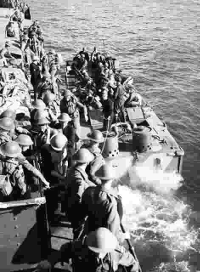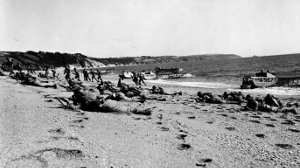Disastrous Precursors to D-Day
Allied commanders learned the hard way how not to conduct amphibious invasions in two disastrous precursors to the D-Day Invasion: the Dieppe raid and Exercise Tiger. On August 19, 1942, Allied forces had launched what was supposed to be a raid on Dieppe, a port city on France's northwest coast, between Calais and Normandy. The idea was to take the port, hold it for a time, and then withdraw. It was a disaster. 
To start with, information that the Allied planners had on the target area was incomplete. They thought that this part of the coast was lightly defended; instead, German gunners had dug in for a long defense, hiding their weapons in the hillside for maximum effect. Late the night before, the landing craft and accompanying ships floated across the English Channel. Radar stations in England identified the presence of a Germany convoy and radioed the mission commander, twice; the convoy continued on the same course. The landing craft were flimsy and did nothing much to protect the men inside. When the invasion fleet ran into the Germany convoy just before 4 a.m., a firefight ensued and several landing craft were sunk. The rest of the landing craft scattered, and few of the commandos those landing craft carried reached their objectives. Preceding the invasion was not a heavy bombing campaign but protective smoke screen, which was easily dispatched by a timely southerly breeze. As well, the assault was planned for early daylight, when the attacking troops would be clearly visible. To make matters worse, the beach wasn't conducive to keeping heavy machines like tanks above ground level. An accompanying series of volleys from the destroyers and other attack ships that had accompanied the landing craft made a dent in the German fences but not much of a dent; as a result, very few of the men who were supposed to land on the beach actually did so with any kind of protection or cover. As a result, the death toll was nearly 4,000. The Allied planners had learned several brutal lessons, all of which they employed in their preparation for D-Day. Allied forces did learn the disasters at Dieppe. Two years later, they conducted a dress rehearsal for D-Day, a mock invasion of Devon, on the southwest coast of England. 
The VII Corps of the U.S. Army was the focus of Exercise Tiger, a dry run of the Normandy landings that took place on April 28, 1944. Their target was Slapton Sands, a beach area that looked very much like Normandy itself. The "invasion forces" had boarded their ships a few days before and then sailed back to England, where they were to cut their way way through miles of barbed wire, concrete barriers, and mines–just as they knew they would have to do at Normandy. To add an aura of authenticity, British forces planned to strafe the beach with live rounds of ammunition several minutes before the planned landing. The first hint of disaster came the day before, when the last small-scale planning exercise was disrupted by the British navy firing on the American landing craft as they were landing, not before. A few American troops died in the friendly fire. Unknown to the Allies, a German contingent of "E-boats" was in the area on April 28 and, when encountering the Allied ships, fired their guns and torpedos. The landing craft was nowhere near the beach when they hit by live fire of a very deadly kind. As German torpedoes began blowing holes in American troop carriers, American troops jumped into the very cold sea. One torpedo hit resulted in an immediate explosion, killing many troops onboard and igniting an oil slick from another landing craft that had been hit. Compounding the tragedy of errors were two blunders by British forces and one by American forces. The Scimitar, a destroyer that was supposed to be escorting the landing craft, was not at sea but back in port, being repaired. As well, British intelligence forces had indeed been tracking the German E-boats, but their warnings to American forces went unheeded because the two militaries were on different radio frequencies at the time. Lastly, the American invasion troops had not received proper training in how to use their life jackets; as a result, many troops died when their combat gear dragged them under the surface. An allied flotilla soon arrived and drove off the E-boats. The task then turned to rescue. Reports were grim: 749 American soldiers dead, with several hundred more injured. No mention of the disaster made its way out of the tight-lipped top circles of Allied commanders, who seriously considered calling off the Normandy invasion because some soldiers who knew important details about it had not yet been found. As with the Dieppe raid, Allied commanders counted their lessons learned and employed them in the meticulous planning for which the Normandy landings became known. |
|
Social Studies for Kids
copyright 2002–2026
David White




